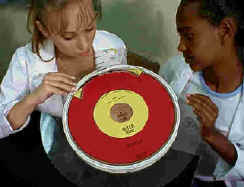BACKGROUND:
Geologists have distinguished three main internal
subdivisions of the Earth, based on the behavior of seismic waves and
laboratory experiments. The outermost layer is the crust. The Earth has two
types of crust. Continental crust underlies much of the Earth’s land
surface. The ocean floors are underlain by oceanic crust. These materials
are composed of different kinds of silicate minerals. The continental crust
is composed mainly of the minerals that are in the igneous rock granite, and
the oceanic crust is mainly composed of minerals that are in basalt.
Underlying the crust is the second layer, the mantle.
It comprises the largest portion of the Earth. Like the crust, it is also
composed of silicate minerals. The innermost portion of the Earth is the
core. It is composed of metallic elements, primarily iron and nickel. The
core is subdivided into two parts. The outer core is liquid metal, while the
inner core is solid. The radius of the Earth is 6371 km (inner core = 1200
km; outer core = 2200 km; mantle = 2900 km; and crust = 71 km).
Remember that the composition of the inner part of the
Earth has not been directly observed. The layers presented above are based
on the interpretation of seismic waves and experimental data by geologists
and seismologists. Remind students that we cannot even drill all the way
through the crust!
The plates are composed of the crust and the uppermost
part of the mantle. These two layers are often called the lithosphere
because they are both composed of solid rock. The underlying, partially
molten part of the mantle, on which the plates slide, is called the
asthenosphere. In contrast to the crust–mantle-core division, which was
based on composition, the lithosphere and asthenosphere are separated based
on strength. The lithosphere is strong, rigid rock, while the asthenosphere
is a weaker, very viscous fluid. The plates are layers of rigid, solid rock.
However, as they move, plates interact at their edges or boundaries. These
interactions generate earthquakes and volcanoes. There are three basic
directions or types of boundary interactions. At diverging plate boundaries,
earthquakes occurs as the plates pull away from each other. Volcanoes form
between the plates, as magma rises upward from the underlying mantle.
Second, two plates may come together, at a converging plate boundary. Two
situations are possible at converging plate boundaries. First, only
earthquakes occur when two plates collide (obduct), building a mountain
range. Second, both volcanoes and earthquakes  form where one plate sinks
under the other, instead of colliding. This process is called subduction.
Finally plates can also slide past each other horizontally. Transform plate
boundaries commonly have only earthquakes.
form where one plate sinks
under the other, instead of colliding. This process is called subduction.
Finally plates can also slide past each other horizontally. Transform plate
boundaries commonly have only earthquakes.
PROCEDURE:
-
Introduce the students to the internal structure of the
Earth. The physiographic globe illustrates these layers well, or use the
presentation image below. Make sure to give them the thickness of each
layer.
-
Introduce students to the basics of plate tectonics.
Describe each type of plate boundary, the type of motion occurring
there, and whether or not earthquakes and volcanoes are generated.